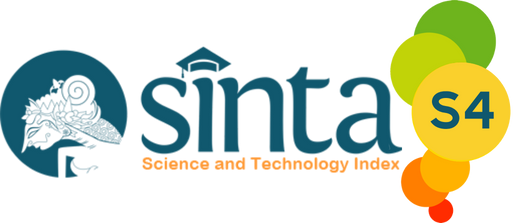Purwarupa Penghapus Papan Tulis Otomatis guna Meningkatkan Efektifitas Proses Belajar Mengajar di Sekolah Dasar
Abstract
In general, primary and secondary schools still erase the blackboard manually. These activities will take up study time in the classroom and can even cause clothes to become dirty. From these problems, an innovation based on microcontroller technology is proposed to clean the blackboard by pressing the push switch. This automatic whiteboard uses a servo that will function as a drive that will move the eraser to clean the board. The micro servo can move because it is connected to the Arduino Uno that has been programmed. The workings of this blackboard eraser prototype are when the switch is pressed, and the micro servo will move the eraser with a large angle of rotation direction that is 90 ° from the bottom up repeatedly until the whiteboard is clean. The research process began with the Double Diamond approach introduced by the British Design Council. It was a design process using a social approach by conducting activities with prospective users of innovation, which are integrated with an approach with design thinking to produce technology-based innovations that are beneficial to candidates that users. After getting the primary solution, it will proceed with making a simple prototype that will be used to test the functions and benefits with potential users. From the results of testing with prospective users, obtained satisfactory results in terms of ease of use of technology, the benefits of innovation, and function in prototypes.
Keywords
Full Text:
PDF (Bahasa Indonesia)References
Bastien, J. M. C. (2010). Usability testing: a review of some methodological and technical aspects of the method", International Journal of Medical Informatics, Elsevier Ireland Ltd, Vol. 79, No. 4, pp e18-e23. https://doi.org/10.1016/j.ijmedinf.2008.12.004
Dedy, H., (2014). Rancang Bangun Alat Penghapus Whiteboard , Tesis S2, Jurusan Teknik Mesin, Universitas Hasanuddin. Makassar https://doi.org/10.24176/simet.v2i1.107
Fibrianie, E, Zainul, R. M., and Cahyadi, D., (2019). Analisis Kelelahan Pekerja Pengolah Kerupuk di Kota Bangun Kalimantan Timur. Jurnal Teknologi Terpadu, Vol.7 No.1 https://doi.org/10.32487/jtt.v7i1.526
Irbīte, A., and Strode, A. (2016). Design thinking models in design research and education, Proceedings of the International Scientific Conference, Vol. IV, pp 488-500 https://doi.org/10.17770/sie2016vol4.1584
Irmalianti, D., Sarwoko, M.,and Sunarya, U., (2012). Penghapus Papan Tulis (white board) Berbasis Mikrokontroler atmega 8535, Tugas Ahir S1, Telkom University
Johnson, G. I., Clegg, C. W., and Ravden, S. J. (1989). Towards Practical User Experience Evaluation Methods, Jornal of Applied Ergonomics, Elsevier Ltd, Vol. 20, No. 4, pp255-260 https://doi.org/10.1016/0003-6870(89)90187-7
Kastner, S., and Knight, R. T. (2017). Bringing Kids into the Scientific Review Process. Journal Neuron, Elsevier Inc, Vol. 93, No. 1, pp 12-14. https://doi.org/10.1016/j.neuron.2016.12.002
Mohammed, A. S., Hussain, M. I., and Zuraidah Bin Zain, (2017). Application of user Centered Design for Customer Requirement in Design Process for Automotive Manufacturing Organizations, IOSR Journal of Mechanical and Civil Engineering, Vol. 14, No. 2.IV, pp 27-31 https://doi.org/10.9790/1684-1402062731
Nusyirwan, D. (2017). Engineering Design Process Engineering Student Centered Experience Learning (ESCEL) di Jurusan Teknik Elektro Universitas Maritim Raja Ali Haji (UMRAH). Jurnal Sustainable, Universitas Maritim Raja Ali Haji, Vol. 6, No. 1, pp 24-35 https://doi.org/10.31629/sustainable.v7i1.444
Premono A., and Pertiwi, A., (2014). Penghapus Papan Tulis Otomatis Berbasis ARDUINO Uno dengan Menggunakan Sensor PIR , Tugas Ahir S1, Gunadarma University.
von Saucken, C., Lachner, F., and Lindemann, U. (2014). Principles for User Experience What We Can Learn from Bad Examples, International Conference on Kansei Engineering & Emotion Research
Wagner, C., Kawulich, B., and Garner, M. (2012). Collecting Data Through Observation, Doing Social Research: A global context, McGraw Hill
Refbacks
- There are currently no refbacks.








